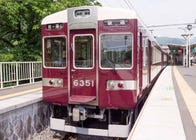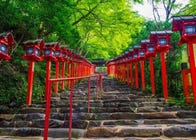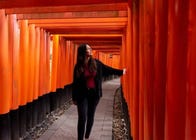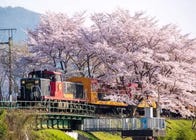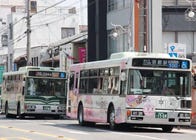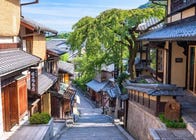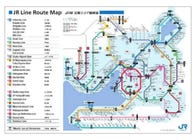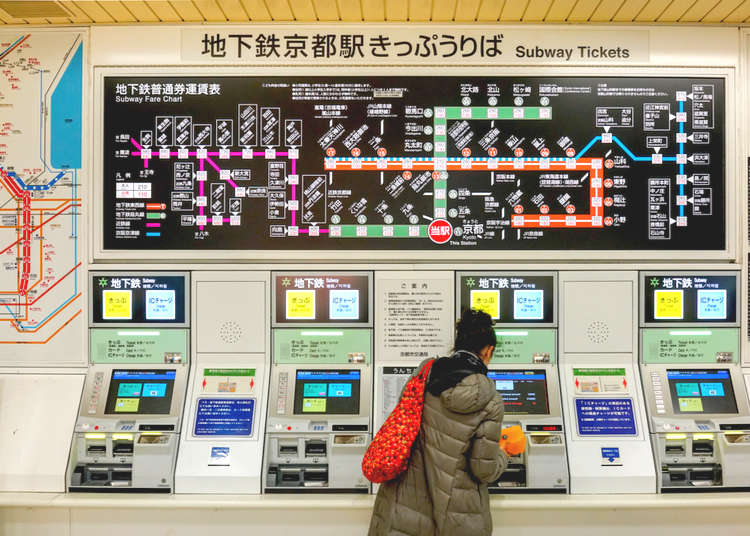
Kyoto, a city rich in history and culture, captivates visitors with its enchanting temples, serene gardens, and vibrant festivals. As you embark on your journey through this remarkable city, mastering the art of getting around efficiently becomes paramount. That's where Kyoto's extensive network of trains and subways comes into play, seamlessly connecting the city's major attractions and hidden gems.
In this comprehensive guide, we will delve into Kyoto's trains and subways, unlocking the secrets of this intricate transportation system. Whether you're a curious traveler eager to explore Kyoto's wonders or a savvy commuter seeking to navigate the city's bustling streets, this guide will equip you with the knowledge and confidence to navigate the railway lines and subway routes like a local.
- Table of Contents
-
- 1. Hankyu Railway: Conveniently connecting Osaka, Kyoto & Kobe
- 2. Eizan Electric Railway (Eizan Main Line, Kurama Line): Easy access to Kifune and Kurama
- 3. Kintetsu Nara Line: Exploring Kyoto and Nara made simple
- 4. Keifuku Electric Railroad (Arashiyama Line, Kitano Line): Kyoto City's unique above-ground railroad
- 5. Kitakinki Tango Railway (Miyafuku Line, Miyazu Line, Miyamai Line): Accessing Amanoshidate effortlessly
- 6. Kyoto Municipal Subway (Karasuma Line, Tozai Line): Navigating Kyoto City with two subway lines
- 7. JR-West: Seamless travel between Kyoto, Osaka, and Nara
- 8. Keihan Electric Railway (Keihan Main Line, Otsu Line): Linking Kyoto and Osaka with ease
1. Hankyu Railway: Conveniently connecting Osaka, Kyoto & Kobe
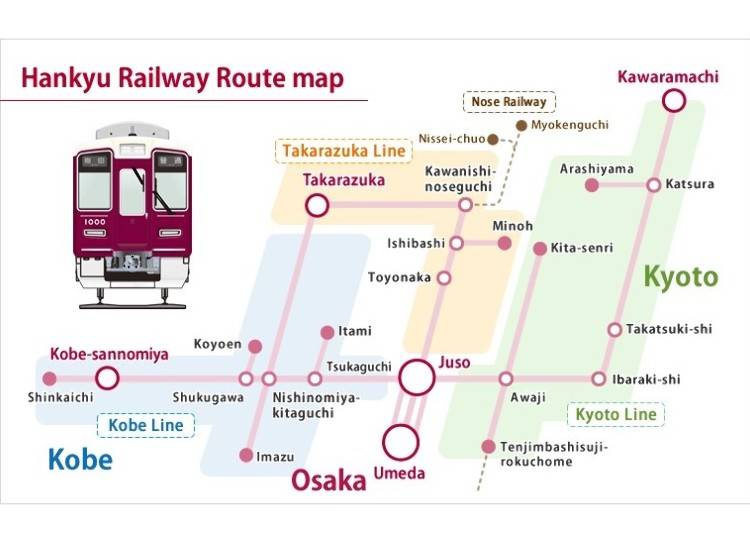
The Hankyu Railway, as the sole privately owned railway connecting Kawaramachi (Kyoto), Umeda (Osaka), and Kobe-Sannomiya (Kobe), plays a crucial role in linking these vibrant metropolitan areas within the Kansai region.
The Hankyu Railway offers diverse routes with its extensive network comprising nine lines: the Kyoto Line, Takarazuka Line, Kobe Line, Arashiyama Line, Senri Line, Minoo Line, Itami Line, Kyoto Line, and Imazu Line. Notably, the Kyoto Line and Kobe Line are particularly popular among sightseers.
For travelers journeying from Kawaramachi (Kyoto) to Umeda (Osaka), the Kyoto Line's limited-express train is the ideal choice, completing the trip in approximately 45 minutes. Meanwhile, those heading to Kobe-Sannomiya in Kobe can conveniently transfer at Juso Station from the Kyoto Line's limited-express service to the Kobe Line's limited-express train. With a total travel time of around 1 hour and 20 minutes for this cross-prefecture trip, the Hankyu Railway ensures a convenient and efficient experience.
Additional suggestion:
Considering the frequency of travel between these major destinations, travelers may find it beneficial to consider the Hankyu Tourist Pass, which offers unlimited rides on the Hankyu Railway lines for a designated period, allowing for seamless exploration of the region's top attractions.
2. Eizan Electric Railway (Eizan Main Line, Kurama Line): Easy access to Kifune and Kurama
When planning an excursion to Kifune, Kurama, or an adventure beyond Kyoto City towards the Mount Hiei area, the Eizan Electric Railway proves to be a perfect choice.
Seamlessly connecting Demachiyanagi Station to Yase-Hieizanguchi Station, the Eizan Main Line ensures a smooth and convenient journey. And with a reasonable travel time of around 31 minutes, passengers can easily reach their desired destinations from Demachiyanagi Station to Kurama Station, providing effortless access to Kifune Shrine and other picturesque spots.
For those seeking to explore the captivating Mount Hiei, a delightful 15-minute ride on the Eizan Main Line from Demachiyanagi to Yase-Hieizanguchi is all it takes. This swift and scenic journey will transport you to the enchanting foothills of Mount Hiei, where you can immerse yourself in the natural wonders and cultural treasures that await.
Additional suggestion:
Consider obtaining the Kyoto-Osaka Sightseeing Pass with Hirakata Park/Greater Kurama and Kibune Area Day Pass, a convenient option for travelers wishing to make the most of their exploration along the Eizan Electric Railway. This pass provides unlimited rides during the valid period, granting you the freedom to fully experience the beauty and attractions of Kifune, Kurama, and the Mount Hiei area.
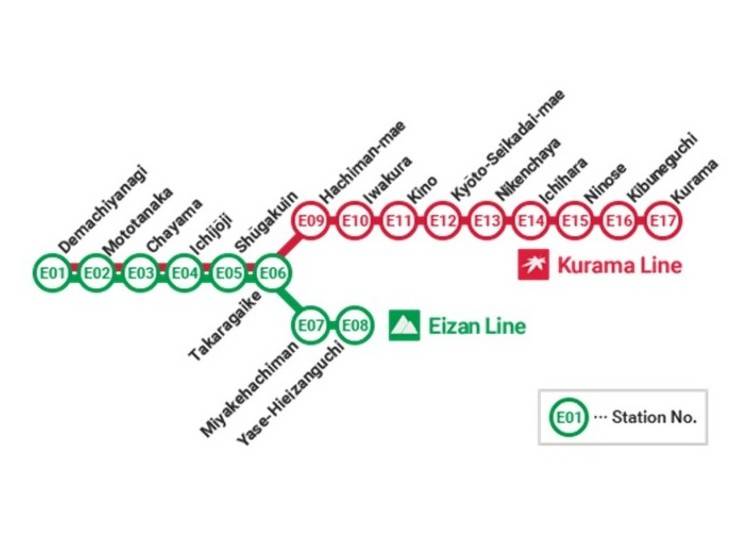
3. Kintetsu Nara Line: Exploring Kyoto and Nara made simple
The Kintetsu Railway proudly claims the title of the longest private railway in Japan, stretching across Osaka, Kyoto, Nara, Mie, and even extending to Aichi Prefecture. While providing connectivity to a diverse range of destinations, it excels in catering to the needs of sightseers.
Among the notable lines for sightseeing, the Kintetsu Kyoto Line emerges as a remarkable choice. This line connects Kyoto Station to Nara City's Yamato-Saidaiji Station, offering a seamless journey through captivating landscapes and cultural treasures. Similarly, the Namba/Nara Line operates from Osaka-Namba Station to Kintetsu Nara Station, providing convenient access for sightseers.
Noteworthy stops along the Kintetsu Kyoto Main Line include Kintetsu-Tambabashi Station, where Fushimi Castle awaits exploration, as well as Fushimi-Inari Station, offering access to the famous temple and torii gates of Fushimi Inari Taisha. Each of these destinations presents unique opportunities to delve into captivating cultural and historical experiences.
Additional suggestion:
Consider making use of the Kintetsu Rail Pass, an excellent option for travelers seeking a cost-effective and flexible way to explore the Kintetsu Railway network. This pass grants unlimited rides on designated Kintetsu lines, allowing you to make the most of your sightseeing adventures across Osaka, Kyoto, Nara, Mie, and beyond.
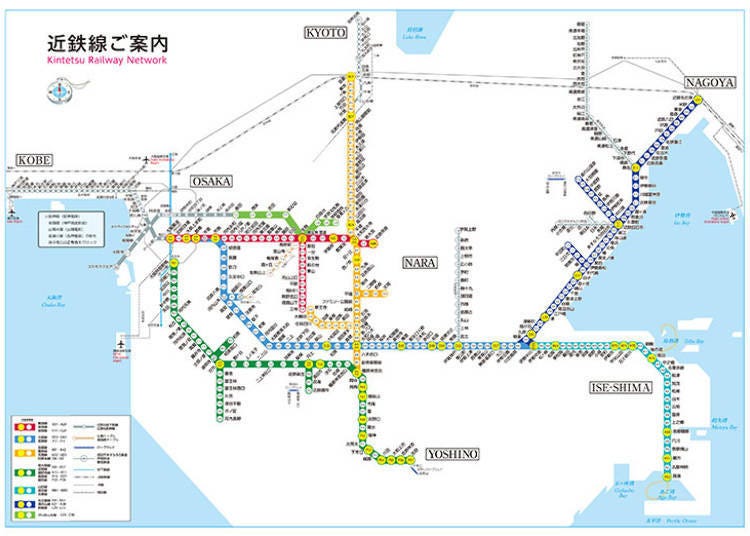
4. Keifuku Electric Railroad (Arashiyama Line, Kitano Line): Kyoto City's unique above-ground railroad
The Keifuku Electric Railroad (or Randen) encompasses two distinctive train lines, each offering its own unique charm. The Arashiyama Main Line spans approximately 7.2 km, connecting Shijo-Omiya and Arashiyama, where the renowned Togetsukyo Bridge awaits. On the other hand, the Kitano Line extends for 3.8 km, linking Katabiranotsuji to Kitano Hakubaicho.
Operating as delightful above-ground railway streetcars, both lines showcase an array of charming train designs, ranging from retro-style cars to those inspired by police vehicles.
Embarking on a journey between Shijo-Omiya Station and Arashiyama Station grants you a delightful experience, with an approximate travel time of 25 minutes. Along the way, you'll encounter Uzumasa-Koryuji Station, conveniently located near Koryu-ji, considered Kyoto's oldest temple, as well as the exciting Toei Kyoto Studio Park amusement park.
Along the Kitano Line, you'll find Ryoanji Station, conveniently situated near Ryoan-ji Temple, renowned for its captivating stone garden. Additionally, Kitano-Hakubaicho Station offers easy access to Kitano Tenmangu Shrine and the mesmerizing Kinkaku-ji Temple.
Additional suggestion:
Consider obtaining the Randen + Subway 1 Day Pass, a recommended option for those planning to explore the city via the Randen and subway.

5. Kitakinki Tango Railway (Miyafuku Line, Miyazu Line, Miyamai Line): Accessing Amanoshidate effortlessly
The Kitakinki Tango Railway lines traverse the picturesque Tango region in northern Kyoto and extend to the Tajima area in northeastern Hyogo Prefecture. This charming railway network consists of three distinct lines, each offering its own unique journey.
The Miyafuku Line connects Fukuchiyama City to Miyazu City, showcasing the scenic beauty of the region.
The Miyamai Line links Maizuru City with Miyazu City, presenting travelers with captivating landscapes along the way.
Lastly, the Miyazu Line stretches from Miyazu City, passing through Yosano-cho and Kyotango City, and culminates in Toyooka City in Hyogo Prefecture.
Notably, the Miyazu Line features a stop at Amanohashidate, recognized as one of the esteemed Three Views of Japan. This breathtaking location offers visitors a memorable experience, with its stunning sandbar and breathtaking natural surroundings.
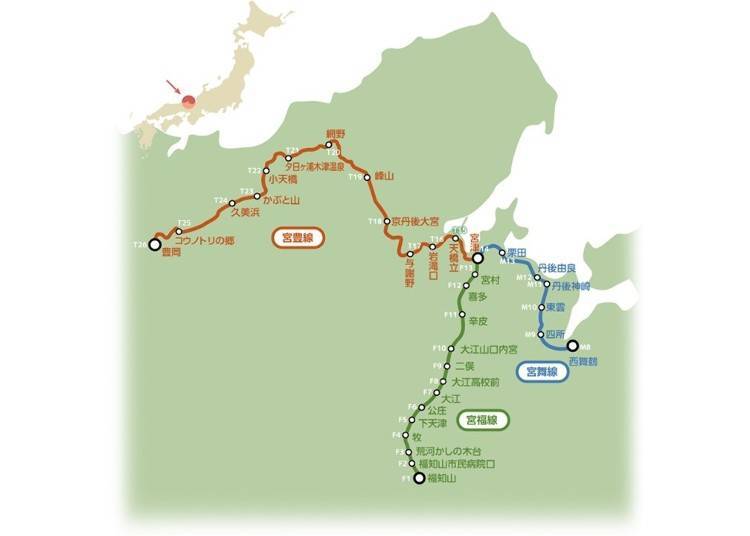
6. Kyoto Municipal Subway (Karasuma Line, Tozai Line): Navigating Kyoto City with two subway lines
The Kyoto Municipal Subway operates two primary lines that provide convenient transportation within the city.
The Karasuma Line stretches from Kokusaikaikan Station to Takeda Station, spanning from north to south. Meanwhile, the Tozai Line extends from Uzumasa-Tenjingawa Station to Rokujizo Station, offering convenient travel from west to east. The fare for subway rides varies depending on the distance traveled, ranging between 210 and 350 yen.
Notable Tourist Spots along the Karasuma Line include:
・Imadegawa-cho Station, which provides access to the majestic Kyoto Imperial Palace.
・Karasuma Oike Station, where visitors can explore the Kyoto International Manga Museum.
・Kyoto Station, serving as a gateway to various attractions, including Kyoto Tower, Higashi-Honganji Temple, Nishi-Honganji Temple, Sanjusangen-do Temple, and Toji Temple.
Noteworthy Tourist Spots along the Tozai Line include:
・Nijojo-mae Station, conveniently located near the splendid Nijo Castle.
・Karasuma Oike Station, where travelers can visit the Kyoto International Manga Museum.
・Shiyakusho-mae Station, offering access to the historical Honno-ji Temple.
・Higashiyama Station, providing a gateway to the elegant Heian Jingu Shrine.
・Keage Station, which grants easy access to Zenrin-ji Temple (Eikan-do Temple) and Nanzen-ji Temple, known for their scenic beauty and cultural significance.
Additional suggestion:
Consider utilizing the Randen + Subway 1 Day Pass, a recommended option for visitors planning to explore Kyoto using the Kyoto Municipal Subway. This pass allows unlimited rides on the subway lines, providing convenient and cost-effective access to the city's popular tourist spots and landmarks.
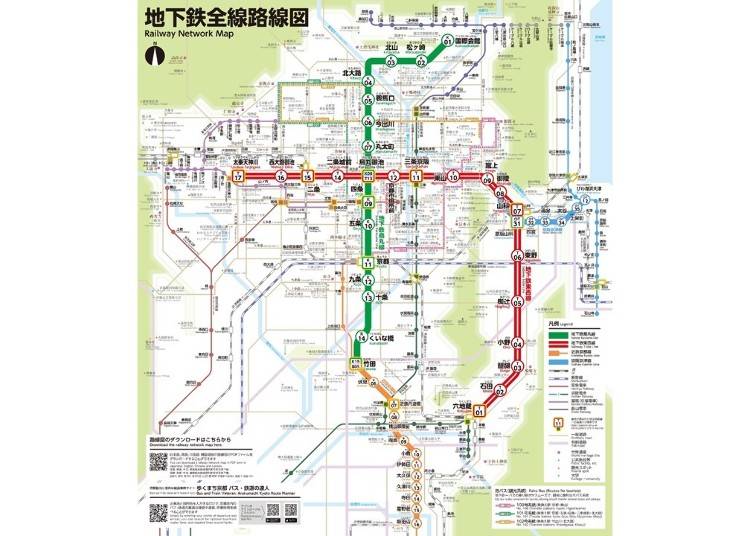
7. JR-West: Seamless travel between Kyoto, Osaka, and Nara
Kyoto is crisscrossed by a network of JR lines, providing ample transportation options for sightseeing. Among these lines, the Kyoto Line and the Nara Line stand out as popular choices.
The Kyoto Line offers a convenient limited-express train service, ensuring a swift and efficient journey from Kyoto to Osaka in approximately 30 minutes. This rapid connectivity between the two cities allows travelers to make the most of their time and explore the vibrant attractions of both Kyoto and Osaka.
For those seeking to discover the cultural wonders of Nara, the Nara Line presents a scenic journey. Traveling from Kyoto to Nara aboard an express train takes approximately 45 minutes, allowing visitors to immerse themselves in the rich heritage and historic treasures that await in Nara.
Additional suggestion:
Consider obtaining the <@Japan Rail Passa=https://livejapan.com/en/reserve/transportation/t00000002@> or Kansai WIDE Area Excursion Pass, a recommended option for travelers planning to explore the Kansai region, including Kyoto and Nara, using the JR lines. Both passes provide unlimited rides on designated JR lines, allowing for flexible and convenient sightseeing across multiple destinations within the region.
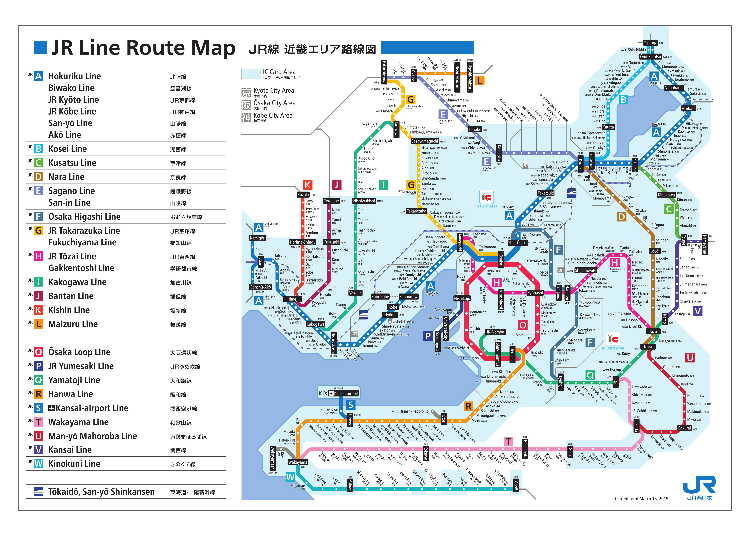
8. Keihan Electric Railway (Keihan Main Line, Otsu Line): Linking Kyoto and Osaka with ease
The Keihan Railway provides a vital link between Kyoto and Osaka, with its name derived from the Japanese characters representing the cities' names (Kyoto's "kyo" can also be read as "kei," and Osaka's "o" can also be read as "han").
The railway encompasses several lines, including the Kyoto Main Line, Uji Line, Katano Line, and Keishin Line. Among these, the Keihan Main Line and Uji Line are particularly popular for sightseeing purposes. The former serves as a convenient transportation option for traveling between Kyoto and Osaka, while the latter is well-suited for visiting notable attractions such as Byodo-in Temple.
The Keihan Main Line concludes its journey in Kyoto at Demachiyanagi Station, while in Osaka, the line stops at Yodoyabashi Station and Nakanoshima Station. Traveling from Demachiyanagi Station in Kyoto to Yodoyabashi Station in Osaka takes approximately 55 minutes aboard a limited-express train, ensuring a relatively swift and comfortable commute.
Additional suggestion:
For a more convenient and cost-effective travel experience, consider using the Kyoto-Osaka Sightseeing Pass, which offers unlimited rides on the Keihan Railway lines, allowing you to explore popular tourist spots and attractions in both Kyoto and Osaka at your own pace.
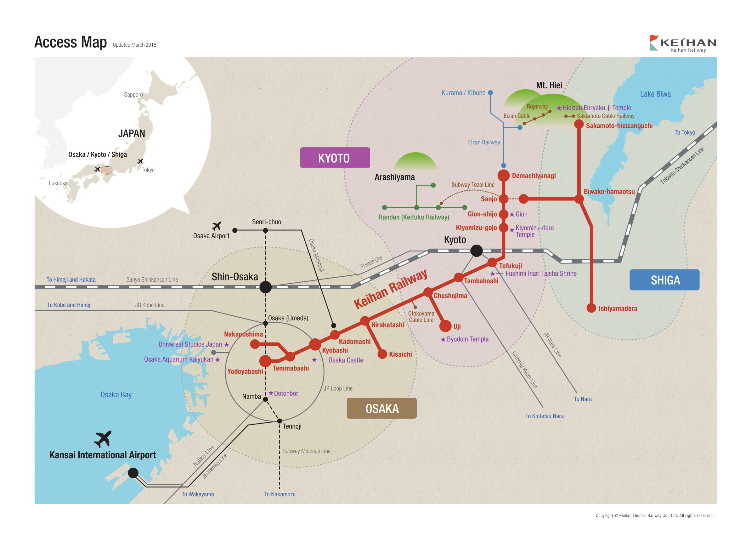
main photo: Boris-B / Shutterstock.com
*Prices and options mentioned are subject to change.
*Unless stated otherwise, all prices include tax.
Popular Tours & Activitiess
Recommended places for you
-
Goods

Yoshida Gennojo-Roho Kyoto Buddhist Altars
Gift Shops
Nijo Castle, Kyoto Imperial Palace
-

Kambei Sannomiyahonten
Yakiniku
Kobe, Sannomiya, Kitano
-

Jukuseiniku-to Namamottsuarera Nikubaru Italian Nikutaria Sannomiya
Izakaya
Kobe, Sannomiya, Kitano
-

ISHIDAYA Hanare
Yakiniku
Kobe, Sannomiya, Kitano
-

Kanzenkoshitsuyakinikutabehodai Gyugyu Paradise Sannomiya
Yakiniku
Kobe, Sannomiya, Kitano
-
Events

Sunflower terminal (Osaka) Terminal 1
Other Sightseeing
USJ, Nanko Port
-

Best Things to Do and See Around Kyoto & Osaka in September: Events and Festivals in Kansai
-

New Way to Reach Koyasan! Ride Nankai's 'GRAN Tenku' for a Heavenly Journey
by: Guest Contributor
-
Ad

Experiencing Manga as Culture, Not Just Reading It: Expo 2025 with Rumiko Takahashi
-

Curious About Sake? I Visited a Sake Brewery in Japan and Here's What I Learned
-

Everything You Need to Know About teamLab Biovortex Kyoto (2025 Insider Guide)
by: Wemmy Chau
-
Ad

Café Bahnhof in Osaka: The home-roasted coffee that captivated G20 leaders!
Inspiration for Accommodations
-

Spacious Family Hotel in Namba: 20 Comfortable Stays for Family Fun
-

Charming Hotels to Enjoy the Spectacular Views of Arashiyama's Autumn Leaves from Your Room
-

Experience Stunning Views of Osaka Castle from Private Spaces: Top Hotels Near Osaka Castle
-

Recommended by Visitors! Arashiyama's Best-Rated Hotels
-

Family-Friendly Universal Studios Japan Hotel with Excellent Access
-

Enjoy a Comfortable Stay in Osaka! 10 Hotels with Convenient Airport Shuttle Services
-

Top 10 Recommended Hotels Near Namba Station with Great Access
-

Enjoy Night Views from Your Room! Recommended Hotels in Namba Area
-

Etiquette in Japan: 'I Can’t Take a Photo Here?!' Top 5 Tips Tourists Always Forget in Kyoto
by: Kaori Kimura
-

Top 3 Restaurants: Best Sushi in Dotonbori According to a Local Food Critic
-
Ad

Bus? Train? Which is the Fastest, Easiest Way to Get From Kyoto Station to Kiyomizu-dera, Arashiyama, and Other Tourist Spots? The Winner is...
-

Why Is Osaka So Wildly Popular With Foreign Tourists?
by: WESTPLAN
-

‘What’s Kita and Minami?!’ 5 Weirdly Obvious Osaka Sightseeing Tips Tourists Miss
-

Universal Studios Japan: Guide to Osaka's Giant Theme Park Attractions!
by: WESTPLAN
- #best gourmet Osaka
- #things to do Osaka
- #what to do in kyoto
- #what to bring to japan
- #best gourmet Kyoto
- #new years in Osaka
- #what to buy in nanba
- #Visiting Osaka
- #onsen tattoo friendly arima
- #daiso
- #Visiting Kyoto
- #best japanese soft drinks
- #japanese fashion culture
- #japanese convenience store snacks
- #japanese nail trends













